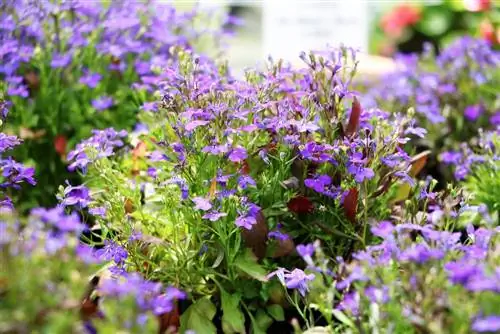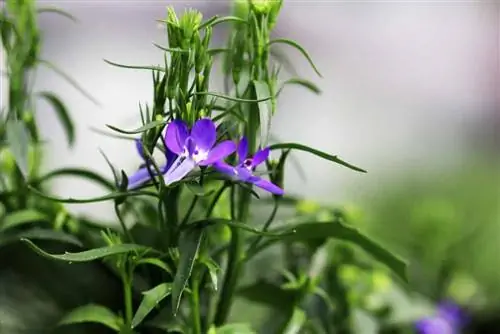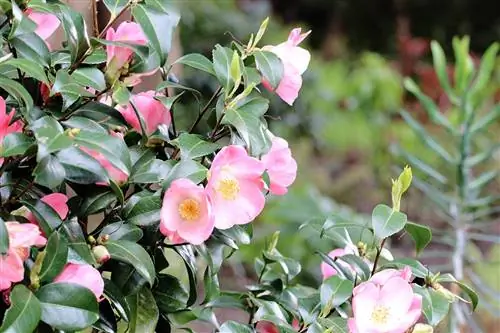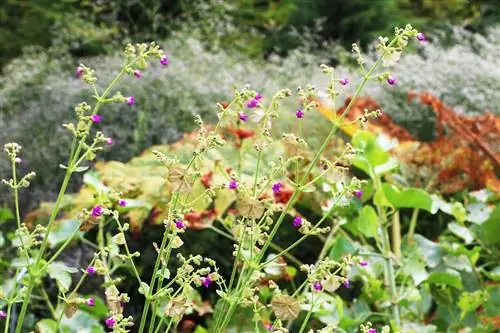- Author admin [email protected].
- Public 2023-12-17 03:39.
- Last modified 2025-01-24 12:45.
Lobelias are pretty and flowering perennials whose numerous bell-shaped flowers can be admired all summer long. With the first frost, however, the lush splendor is over because the attractive plant is not hardy in our area. In addition to the blue-violet-flowering, annual Male True, there are several perennial lobelia species that can be overwintered in the garden under protected conditions.
Blue lobelia not hardy
Under the name “Männertreu” or “Lobelia” a compactly growing perennial with attractive, blue-violet flowers is sold that lasts for months and is particularly popular in balcony boxes or as a plant in the foreground of a perennial bed. This is the species Lobelia erinus, which is native to southern Africa, especially in the Cape region. Due to the subtropical to tropical climate, it is warm there all year round, which is why the plant is not hardy here. Even at temperatures around zero the perennial freezes back.
Cultivate Lobelia erinus as an annual
However, blue lobelia can easily be propagated using seeds, which you can sow in a bowl filled with growing substrate from March onwards. Then grow the seedlings on the windowsill and plant them directly outside after the Ice Saints in May. The numerous cultivars of Lobelia erinus are fast-growing and begin to flower quickly, so overwintering is not necessary. Mannertreu sown in March blooms from the end of May to the beginning of June, depending on the weather.
Tip:
The one-year-old male faithful cannot be overwintered, but you can leave a few withered shoots and collect the ripe fruits with the seeds in the fall for re-sowing in the spring.
Which lobelias can be overwintered?

However, the blue lobelia is not the only species in the large genus of lobelias. Around 430 different species belong to this group, which belongs to the bellflower family (Campanulaceae). Most of them also come from the subtropical to tropical regions of the world and are therefore not suitable for overwintering in the garden. Only the perennial herbaceous lobelias can tolerate frost, but only for a short time. These species, which grow up to around 100 centimeters high, have strong growth and, under certain conditions, can remain outside even in the cold season. Alternatively, overwintering in a cool room is possible if the plants are grown in pots.
These types of perennial lobelias are suitable for overwintering:
- Lobelia cardinalis: “Cardinal Lobelia” or “Bright Lobelia” with strong red flowers, from North America, robust and well hardy
- Lobelia sessilifolia: tall, violet-flowered species for moist locations, from Asia
- Lobelia siphilitica: “Blue Cardinal Lobelia”, tall, blue-violet flowering species for moist locations, robust and comparatively hardy
- Lobelia splendens: scarlet flowering species
- Lobelia x gerardii (hybrid): “Gerard lobelia”, strong purple flowers, very hardy
- Lobelia x speciosa (hybrid): bright red flowering species, well hardy
Overwintering perennial lobelias
Basically you have two options for getting perennial lobelias well over the winter. You can leave specimens planted in the garden outside, but plants cultivated in pots and other planters must overwinter in a bright, little or no heated room. The reason lies in the container itself: While planted perennials are quite well protected from frost by the surrounding soil, the small amount of substrate in the plant pot is not sufficient for adequate winter protection. The substrate freezes after a short frost, so that the roots are damaged and the plant does not sprout again in spring.
Wintering outdoors
Even if some plant dealers claim the opposite: even perennial lobelias that are considered to be well hardy can only tolerate frost for a short time. If the temperatures drop to zero or even minus ten degrees in autumn, this doesn't immediately harm the plants - but it does after a few days. Therefore, you should winterize planted, perennial lobelias by the end of October at the latest:
- water gradually less from August
- Do not fertilize from the end of July / beginning of August
- cut back to a hand's breadth above the ground
- Cover the planting area thickly with brushwood and leaves
- Fir and spruce branches are particularly suitable
- water little in dry winters

Remove the cover as soon as the first warm days come in April. However, protect the tender young shoots from late frosts by continuing to cover them with brushwood or a gardener's fleece overnight. This protective measure should be maintained until mid or end of May - depending on the weather.
Wintering in the cold house
If you grow your perennial lobelias in pots or live in a region with harsh winters and typically heavy snowfall (e.g. in the Eifel or southeastern Germany), you should definitely not overwinter the perennials outdoors. Instead, grow them in large planters and overwinter them as follows:
- Putting into winter quarters from zero point
- but no later than the end of October
- Winter quarters bright and cool
- Examples: unheated bedroom, stairwell, poorly heated greenhouse or winter garden
- Temperatures between five and a maximum of ten degrees Celsius are optimal
- water little, do not fertilize
From mid to late March, gradually increase the amount of watering. From around mid-May, move the overwintered lobelias back outdoors and give them the first fertilization in the form of liquid flowering plant fertilizer.
Tip:
However, do not place them in the blazing sun right away, but rather slowly get the plants used to the new location. Leave them outside a little longer each day and shade them during lunchtime if there is strong light.






